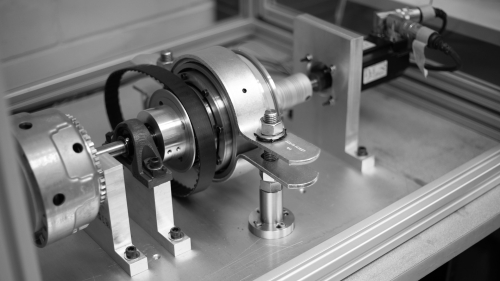While electric cars are rolling off assembly lines in increasing volumes around the world, development of electric trucks has lagged behind. That’s largely because bigger vehicles require bigger, heavier batteries and motors — meaning higher costs, and in turn, less incentive for vehicle manufacturers to bring that technology to market.
But researchers at McGill’s Faculty of Engineering are finding ways to meet that challenge, and are making Canada known as a leader in zero-emission vehicle innovation.
“Electrification of road vehicles would be huge,” says Benoit Boulet, a professor of Electrical Engineering and Associate Vice Principal of Innovation and Partnerships at McGill. “If all vehicles were electrified, we would reduce overall CO2 emissions by 27% in Canada and roughly 43% in Quebec.”
Boulet’s McGill Intelligent Automation Lab has been developing electric drivetrains with industry partners for over a decade.
In 2013, the lab was awarded $4.7 million through the Government of Canada’s Automotive Partnership Canada initiative. That funding, along with $5 million in corporate investments, supported a project to combine electric motor technology from TM4 Electrodynamic Systems of Boucherville, Que., with a drivetrain from Linamar Corp., an automotive supplier based in Guelph, Ont. Infolytica Corp., a Montreal firm that has since been acquired by Siemens, helped develop the software needed to design these advanced electric motor systems.
Purolator pilot
“Our goal was to look at opportunities for electrifying trucks for delivery,” says Boulet. “We figured that courier-type trucks were very appropriate for electrification.” Their short routes, with lots of stop-and-go to drop off and pick up packages, are conducive to operating on batteries: each time a truck decelerates, the electric motor can regenerate energy back into the battery, improving the vehicle’s range. “Companies that operate fleets want to save costs, as well, because fuel costs are extremely high,” Boulet notes.

To test their product, the collaboration turned to Purolator, one of Canada’s leading delivery companies.
The group also needed to find a partner to integrate the electric drivetrain into the truck. For that, they teamed up with Cummins Inc., a leading manufacturer of diesel engines – but one with an eye on the future of electrified power technologies, as well.
One key contribution by the McGill lab was to provide a digital touchscreen display enabling the driver to monitor information about the vehicle, such as the battery’s state of charge.
And so, over two years, an electric Purolator truck quietly plied urban operating routes in Canada – first in Ottawa, then in Montreal.
“We were very happy with the project and its outcome. It went really well,” said Gary Parker, Director for Electrified Power Engineering Programs at Cummins. “The truck ran great. Purolator was very happy with the field-test performance and Cummins was, too,” Parker said in a telephone interview from the company’s Columbus, Indiana, headquarters.
Drivers and customers appreciated the truck’s quiet, pollution-free operation, Boulet says.
Patented drivetrain
Unlike conventional cars, most electric-powered passenger cars operate with single-speed transmissions. For large trucks and buses, it’s very difficult with single-speed transmissions to provide both adequate acceleration from a standstill and the top speeds required for highway travel, Boulet explains. “So companies wind up having to oversize the motor, oversize the power electronics and the battery, to be able to meet both specs.”

To solve that problem, Boulet’s research group has patented a highly efficient dual-speed electric transmission – one that doesn’t require a clutch, and that shifts smoothly between gears. By eliminating the need to oversize other components, their design promises to cut vehicle-manufacturing costs sharply while providing superior performance.
The lab demonstrated the technology to several transmission companies and received a resoundingly positive response. “We’ve shown by extensive simulations that we can save a few percentage points of energy. It doesn’t seem like much, but in this field — that’s what manufacturers crave.”
Transport trucks and beyond
The lab recently collaborated with a major automotive parts supplier to develop advanced multi-speed transmissions for the largest vehicles around — a first step towards getting fully electric transport trucks on the road. “They have the rights to our technology now, and they are developing innovation as part of that,” Boulet explains.
But the applications of such technology go far beyond transport trucks. Boulet has received inquiries from companies around the world — from freight shippers in Korea, to luxury automobile manufacturers in Italy, and even aircraft manufacturers in Montreal.
And when will this technology travel on routes across the road, sea and sky?
“It’s a long road to commercialization,” Boulet explains, “It can be extremely long and difficult, but the development of intellectual property is important.” And labs like Boulet’s — where researchers work directly with industry to engineer technology that is sustainable and effective, all while keeping in mind the bottom line? That’s where the future of clean transportation starts.

